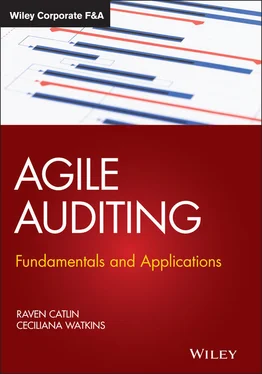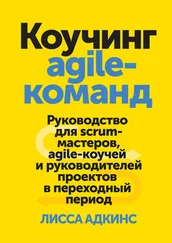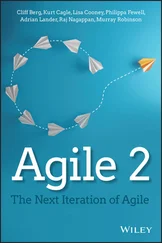Raven Catlin - Agile Auditing
Здесь есть возможность читать онлайн «Raven Catlin - Agile Auditing» — ознакомительный отрывок электронной книги совершенно бесплатно, а после прочтения отрывка купить полную версию. В некоторых случаях можно слушать аудио, скачать через торрент в формате fb2 и присутствует краткое содержание. Жанр: unrecognised, на английском языке. Описание произведения, (предисловие) а так же отзывы посетителей доступны на портале библиотеки ЛибКат.
- Название:Agile Auditing
- Автор:
- Жанр:
- Год:неизвестен
- ISBN:нет данных
- Рейтинг книги:5 / 5. Голосов: 1
-
Избранное:Добавить в избранное
- Отзывы:
-
Ваша оценка:
- 100
- 1
- 2
- 3
- 4
- 5
Agile Auditing: краткое содержание, описание и аннотация
Предлагаем к чтению аннотацию, описание, краткое содержание или предисловие (зависит от того, что написал сам автор книги «Agile Auditing»). Если вы не нашли необходимую информацию о книге — напишите в комментариях, мы постараемся отыскать её.
Machine learning Virtual Conferencing Process automation Data analytics Hugely popular in software development, the agile approach is just making its way into the field of audit. This book provides concrete examples and practical solutions for auditors who seek to implement agile techniques and methods.
Agile Auditing
Agile Auditing — читать онлайн ознакомительный отрывок
Ниже представлен текст книги, разбитый по страницам. Система сохранения места последней прочитанной страницы, позволяет с удобством читать онлайн бесплатно книгу «Agile Auditing», без необходимости каждый раз заново искать на чём Вы остановились. Поставьте закладку, и сможете в любой момент перейти на страницу, на которой закончили чтение.
Интервал:
Закладка:
Since 2011, “I” became “we” as the Raven Global Training team expanded. Expert trainers joined, and courses increased, including courses on Agile auditing. Ceciliana was the first instructor we officially added to the team. We continually collaborate on many topics and bounce ideas off each other – it is a great partnership.
We concluded that the auditing profession can, and should, use Agile frameworks and that doing so can solve the root cause of many problems experienced in the audit life cycle, such as poor client relationships. But how? What would this look like? Would it look the same for every audit team? Can it work on every audit? What would we call it? The name Agile auditing felt right, and the rest of the story is provided for you in the pages of this book.
Successful Agile projects are those that recognize failure quickly, through constant inspection, and rapidly adapt to identified failures.
In 2013, we began offering keynote addresses on Agile auditing concepts at conferences. As we continued developing our Agile audit framework, we also sought opportunities to put the framework into practice. Our first client was up for the challenge in 2014, and we knew we might not get it right the first time. In fact, failing, and failing fast, is a collective mindset in Agile disciplines. It is okay to fail. Failure is even expected! Successful Agile projects are those that recognize failure quickly, through constant inspection, and rapidly adapt to identified failures.
Our first full‐day Agile auditing class was offered in Roseland, New Jersey, in September 2014. Back then, our Agile audit framework rigidly aligned the audit process and project management principles used in auditing to the Agile Manifesto, Agile principles, and Scrum framework. Our first Agile audit methodology was too rigid and didn't incorporate our personal auditing experiences. With our second Agile auditing class in Albuquerque, New Mexico, in January 2015, we changed the methodology to reflect more of a framework and incorporated Participatory Auditing principles, more client collaboration, and professional standards for the audit profession. For private sector internal auditing, we turned to the Standards for the Professional Practice of Internal Auditing issued by The Institute of Internal Auditors (IIA). For public sector auditing, we reviewed the Generally Accepted Government Audit Standards (GAGAS), commonly referred to as the Yellow Book. For audits of external financial reporting, we researched the Generally Accepted Auditing Standards (GAAS).
As Steven Denning points out in his book The Age of Agile , Agile started as a movement that took off in 2001 as a set of values and principles articulated by the Agile Manifesto of 2001. The manifesto spawned various management methodologies including Scrum and many others (Denning 2018). Over time, it evolved into a movement of people with a specific mindset that focuses on delivering continuous value to customers. As we started our journey in Agile, we soon realized the importance of distinguishing a framework from a methodology to facilitate the Agile auditing movement.
So, what is the difference between a methodology and a framework? According to the Cambridge Dictionary, methodology is defined as “a system of ways of doing, teaching, or studying something” (Cambridge Dictionary 2020b). Basically, a methodology is a systematic way of doing or accomplishing something. If we apply an Agile methodology, we must have systematic procedures. Methodologies are prescriptive – they tell us how to do something in a step‐by‐step manner. On the other hand, the term framework is defined as “a supporting structure around which something can be built” or “a system of rules, ideas, or beliefs that is used to plan or decide something” (Cambridge Dictionary 2020a). Therefore, a framework provides guidelines or a structure that we can work under. A framework allows us to be flexible and adaptive. While a framework has a general structure, the user is not guided through specific steps or processes to get to results. A framework has flexibility within its structure, enabling the user to be supple and to adopt responses to change without having to follow specific steps. Therefore, Agile auditing is a framework that provides options to develop your approaches, methods, practices, and techniques to complete audits faster, with minimal waste, while emphasizing risks and delivery of value to customers. In other words, we are providing an Agile audit framework for you to create your Agile audit methodology. Nonetheless, our experiences have shown us that auditors need something more methodical to start implementing Agile auditing and to increase the success rate with the Agile approach. Thus, we found providing special “recipes” to implement Agile have been of great assistance to auditors in their Agile journey. You will find these recipes at the end of various chapter, as appropriate.
We have made every effort to provide as much useful information as possible to help you find your success on your Agile auditing journey. Thank you for choosing this book. Please enjoy!
Acknowledgments
When we set out to write this book, we soon realized the immensity of the challenges and opportunities we were facing. No matter how vast our knowledge and experience and how many books we read, we could not operate alone: we needed our Agile team!
This book would not have been possible without the help of all our former bosses and audit teams who taught us about auditing. We are very grateful to our fellow audit professionals as a whole. Without them, we would not have had great examples of lessons learned and ideas on improving audit processes. We acknowledge that Agile auditing would not have been possible if it were not for the authors and practitioners who pioneered Agile frameworks in system development and other organizational initiatives. Additionally, the Agile auditing framework wouldn't be where it is if it were not for our Agile auditing clients, conference participants, and classroom students who challenged our thinking and confirmed our approach. The bosses, fellow auditors, authors, practitioners, clients, conference participants, and students are too numerous to list, but we thank them all.
We especially want to express our gratitude to the magnificent and supportive staff of our publisher, John Wiley & Sons. They know their business and do things right. Sheck Cho, Elisha Benjamin, and Susan Cerra, you made this book happen. You unknowingly helped us confirm that using the Agile framework, anything can be done. We thank our many colleagues, friends, and family members who have played a pivotal role in completing this book or learning key concepts, or both.
Raven is especially thankful for the following:
Ceciliana Watkins, friend and co‐author, for stepping in to help me write the book, editing the book, and sharing her unique expertise and perspective as a government auditor.
Carmen Catlin, sparkling daughter, for her beautiful smiles, warm hugs, encouraging words, and for being our delightful illustrator.
Jean Louk, Mom, for her endless love and support.
Christina Magargle, sister, for always knowing every one of my smallest thoughts and needs to finish the book even before I knew them.
Vicki McIntyre, friend, for being a voice of reason and encouragement and for her endless hours editing the book.
Ceciliana is especially thankful for the following:
Raven Catlin, friend and co‐author, for her sharing audit knowledge, believing in me, and providing opportunities to expand my creativity and brain.
Pheary Watkins, husband extraordinaire, for his never‐ending support and for making my dreams come true.
Helm Zinser‐Watkins, my marvelous child, for editorial skills, support, and love and kindness in all my pursuits.
Читать дальшеИнтервал:
Закладка:
Похожие книги на «Agile Auditing»
Представляем Вашему вниманию похожие книги на «Agile Auditing» списком для выбора. Мы отобрали схожую по названию и смыслу литературу в надежде предоставить читателям больше вариантов отыскать новые, интересные, ещё непрочитанные произведения.
Обсуждение, отзывы о книге «Agile Auditing» и просто собственные мнения читателей. Оставьте ваши комментарии, напишите, что Вы думаете о произведении, его смысле или главных героях. Укажите что конкретно понравилось, а что нет, и почему Вы так считаете.











